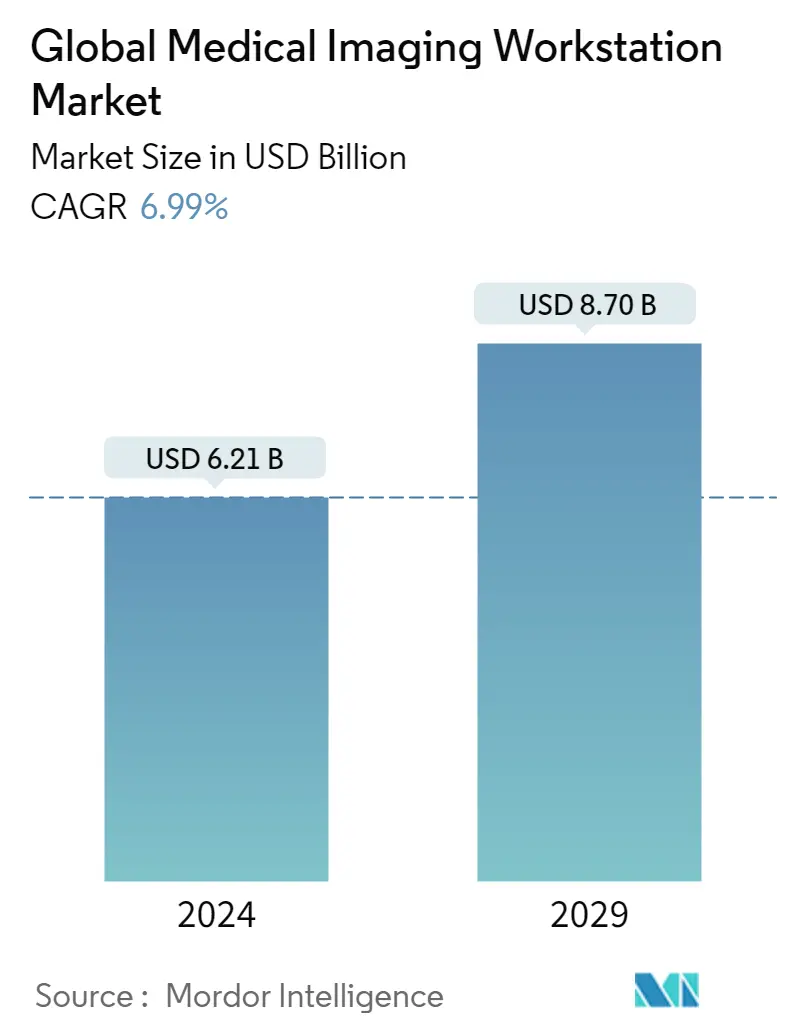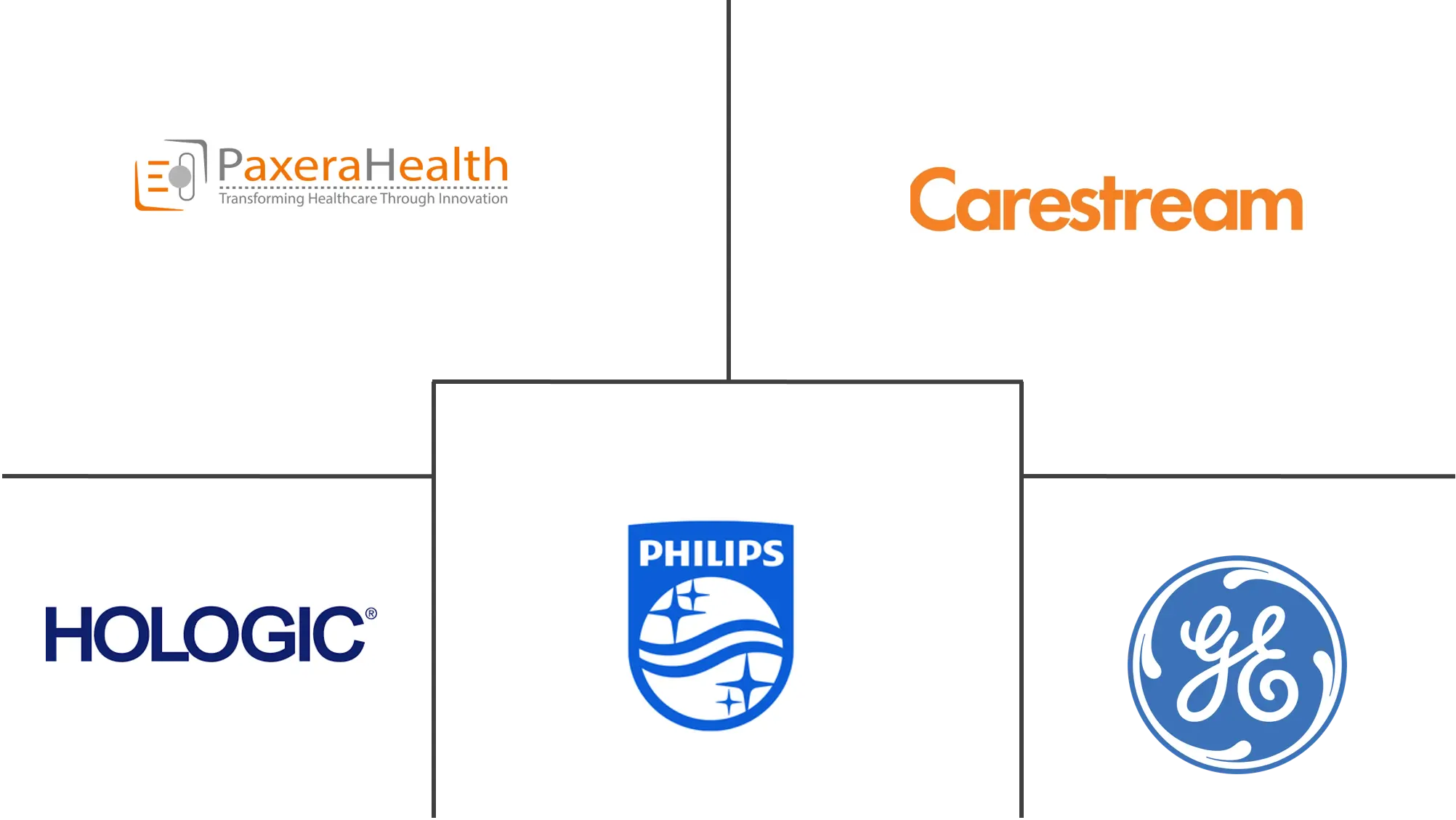Market Size of Global Medical Imaging Workstation Industry

| Study Period | 2019 - 2029 |
| Market Size (2024) | USD 6.21 Billion |
| Market Size (2029) | USD 8.70 Billion |
| CAGR (2024 - 2029) | 6.99 % |
| Fastest Growing Market | Asia Pacific |
| Largest Market | North America |
Major Players
*Disclaimer: Major Players sorted in no particular order |
Need a report that reflects how COVID-19 has impacted this market and its growth?
Medical Imaging Workstations Market Analysis
The Global Medical Imaging Workstation Market size is estimated at USD 6.21 billion in 2024, and is expected to reach USD 8.70 billion by 2029, growing at a CAGR of 6.99% during the forecast period (2024-2029).
The Covid-19 pandemic has shown a significant impact on the market studied. The application of imaging for the diagnosis and treatment of COVID-19 and associated diseases has positively impacted the market's growth. For instance, a BMC Pulmonary Medicine Journal article titled 'Chest x-ray findings and temporal lung changes in patients with COVID-19 pneumonia' published in September 2020 reported that almost half of patients with COVID-19 have abnormal chest x-ray findings with peripheral ground-glass opacification affecting the lower lobes being the most common finding. Moreover, as per a study titled "Rapid Deployment of Home PACS Workstations to Enable Social Distancing in the Coronavirus Disease (COVID-19) Era," published in the American Journal of Roentgenology in December 2020, the radiologist department decided to deploy a number of interpretation PACS workstations at the homes of various radiologists to help with social distancing, protect vulnerable radiologists and others in the hospital, and ensure seamless interpretation capabilities in emergency scenarios. Thus, COVID-19 significantly impacted the medical imaging workstation market,
The growth is attributed to technological advancements in imaging systems that require sophisticated operating units and workstations for smooth operation. The rising technological advancements, supported by the novel launches of products by the key players, are also expected to take the market to new heights. For Instance, in October 2021, JVC launched the CL-S600, a 30-inch medical imaging monitor. 6-megapixel wide color monitor for displaying various diagnostic images on one workstation.
In addition, the growing number of chronic diseases coupled with the rising healthcare expenditure around the world is projected to boost the market growth. Also, the introduction of advanced display and image processing modalities is anticipated to boost the existing workstation and further fuel the market growth. For instance, as per the April 2021 report of the World Health Organization (WHO), non-communicable diseases (NCDs), also known as chronic diseases, are long-duration diseases and are the result of a combination of genetic, physiological, environmental, and behavioral factor and NCDs are responsible for about 41 million deaths every year around the world, which is about 71% of all deaths globally. As per the same source, cardiovascular diseases are the major form of NCDs, followed by cancer, respiratory diseases, and diabetes, and 77% of all NCD deaths are in low- and middle-income countries.
Additionally, rising healthcare expenditure is anticipated to boost the market over the forecast period. According to Eurostat data published in December 2021, Germany and France had the highest current healthcare expenditure relative to GDP in 2019. The level of current healthcare expenditure in Germany was EUR 403 billion in 2019 and remained at the highest level among the European Union (EU) and the Member States. Current healthcare expenditure in Germany and France was equivalent to 11.7 % and 11.1 %, respectively, of gross domestic product (GDP), more than in any other EU Member State. The next highest ratios were in Sweden (10.9 %), Belgium (10.7 %), Austria (10.4 %), the Netherlands (10.2 %), and Denmark (10.0 %); none of the remaining EU Member States recorded double-digit ratios. Hence, the increasing healthcare expenditure is likely to support the market growth
Thus, all aforementioned factors anticipated boosting the market over the forecast period. However, the high cost of imaging systems and lack of skilled professionals is expected to hamper the market progress over the forecast period.
